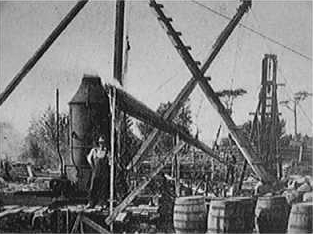Captain Kidd's Buried Treasure
 As mentioned in Monday's post, Kidd got into a little trouble with the government. Though technically a privateer for England, he had a misunderstanding with the British East India Company, and that coupled with political goings-on contributed to his downfall. Whatever led to his unhappy ending, Kidd discovered he was wanted as a pirate and took off for Boston to get the backing of influential friends in New York (where he lived).
As mentioned in Monday's post, Kidd got into a little trouble with the government. Though technically a privateer for England, he had a misunderstanding with the British East India Company, and that coupled with political goings-on contributed to his downfall. Whatever led to his unhappy ending, Kidd discovered he was wanted as a pirate and took off for Boston to get the backing of influential friends in New York (where he lived). He stopped in various parts of New Jersey first and then headed for Boston, Mass., to meet with the governor, who promptly arrested him when he arrived. Captain Kidd claimed he hid 40,000 British Pounds and he wasn't lying entirely. British authorities dug up nearly 10,000 Pounds of treasure on Gardiner's Island off of Long Island. Kidd insisted he had lots more buried where that came from. Unfortunately, he didn't get a chance to prove it and a quick trial and hanging proceeded.
Despite repeated attempts at finding the rest of Kidd's buried treasure, nothing but a few coins on Block Island (off of Rhode Island) has ever turned up. Did he bury more loot and we just haven't found it? Or was Kidd lying to save his own skin? It's too bad he didn't leave a map.
Treasure on Oak Island?
While a small island off of Nova Scotia may not seem like the place to find buried treasure, it was a hot spot for pirates in the 18th century. So in 1795 when Daniel McGinnis stumbled on a strange circular depression in the earth covered by some tree branches that looked like someone cut them to work as a pulley, he grabbed two of his friends and they got to work.
They and future treasure hunters dug and dug, unearthing flagstones, oak timbers, charcoal, putty, coconut fiber, inscribed stone, spruce, metal pieces. What does it equal? Basically, a clever safe equipped with booby traps. When the original discoverers returned to dig again eight years later with The Onslow Company, they sprung a trap and water flooded the pit. No matter what methods they tried, the pit always flooded and they couldn't pump it out fast enough to extract the treasure.
Later, in the 1840s, another company brought in a drill to see what was actually down there, pulling up samples of the items mentioned in the previous paragraph. They decided the wood and metal pieces were chests filled with money. After testing various methods and failing every time, The Truro Company discovered that the booby trap designer had created a drain system. Though this should have solved the problem, the company's two attempts to block the drain failed and they gave up.
But other treasure hunters followed through the decades, four of them losing their lives in the process. More recently, in the 1970s, treasure hunters discovered a human corpse and treasure chests using modern camera equipment. They tried to dive the site but strong currents and visibility issues inhibited any further searches. Even with modern machinery and technology, no one has unearthed whatever is buried. It's incredible that the booby trap is just as effective 300 years or so later!
Bonus Treasure
Before hanging for piracy, Olivier le Vasseur apparently told the spectators that he had buried treasure and flung a necklace into the crowd with a cryptogram that led to it. In the 1920s a woman found evidence that le Vasseur buried his treasure in the Seychelles. After decades of work and clue deciphering, nothing of real value was ever unearthed.
Get detailed info about Kidd and Oak Island at these wonderful websites:
The Mysterious & Unexplained
Mysteries of Canada
Kidds Island
Check back tomorrow as we wrap-up Pirate Week!
Photos from Wikimedia Commons
